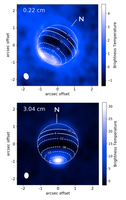Probing the Depths of Neptune
 The authors present spatially resolved (0.1-1.0 arcsec) radio maps of Neptune acquired with the Jansky Very Large Array and the Atacama Large Millimeter/submillimeter Array between 2015 and 2017. Combined, these observations probe from just below the main methane cloud deck at ∼1 bar down to the NH4SH cloud at ∼50 bar. Prominent latitudinal variations in the brightness temperature are seen across the disk. Depending on wavelength, the south polar region is 5 K to 40 K brighter than the mid-latitudes and northern equatorial region. The authors use radiative transfer modeling coupled to Markov Chain Monte Carlo methods to retrieve H2S, NH3, and CH4 abundance profiles across the disk, though only strong constraints can be made for H2S.
The authors present spatially resolved (0.1-1.0 arcsec) radio maps of Neptune acquired with the Jansky Very Large Array and the Atacama Large Millimeter/submillimeter Array between 2015 and 2017. Combined, these observations probe from just below the main methane cloud deck at ∼1 bar down to the NH4SH cloud at ∼50 bar. Prominent latitudinal variations in the brightness temperature are seen across the disk. Depending on wavelength, the south polar region is 5 K to 40 K brighter than the mid-latitudes and northern equatorial region. The authors use radiative transfer modeling coupled to Markov Chain Monte Carlo methods to retrieve H2S, NH3, and CH4 abundance profiles across the disk, though only strong constraints can be made for H2S.
Below all cloud formation, the data are well fit by 53.8+18.9−13.4 x and 3.9+2.1−3.1 x protosolar enrichment in the H2S and NH3 abundances, respectively, assuming a dry adiabat. Models in which the radio-cold mid-latitudes and northern equatorial region are supersaturated in H2S are statistically favored over models following strict thermochemical equilibrium. H2S is more abundant at the equatorial region than at the poles, indicative of strong, persistent global circulation. These results imply that Neptune's sulfur-to-nitrogen ratio exceeds unity, as H2S is more abundant than NH3 in every retrieval. The absence of NH3 above 50 bar can be explained either by partial dissolution of NH3 in an ionic ocean at GPa pressures or by a planet formation scenario in which hydrated clathrates preferentially delivered sulfur rather than nitrogen onto planetesimals, or a combination of these hypotheses.
Image Caption: Examples of VLA and ALMA images of Neptune.
Publication: Joshua Tollefson (University of California, Berkeley) et al., Neptune's Spatial Brightness Temperature Variations from the VLA and ALMA, 2021, The Planetary Science Journal, 2, Issue 3, L105.




Connect with NRAO